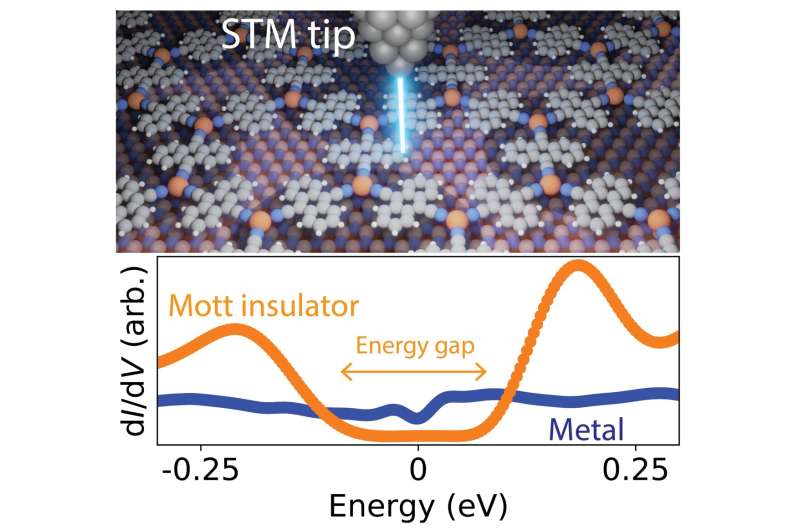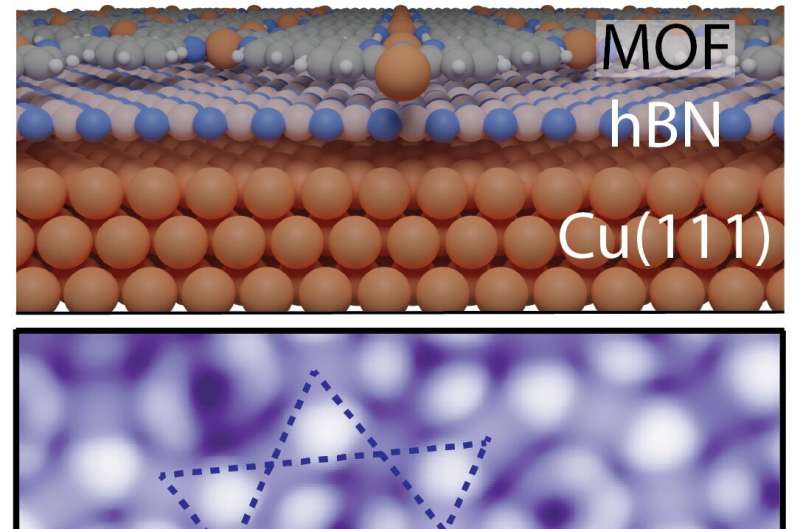This article has been reviewed according to Science X's editorial process and policies. Editors have highlighted the following attributes while ensuring the content's credibility:
fact-checked
peer-reviewed publication
proofread
When does a conductor not conduct? Switching a 2D metal-organic framework from an insulator to a metal

An Australian-led study has found unusual insulating behavior in a new atomically-thin material—and the ability to switch it on and off.
Materials that feature strong interactions between electrons can display unusual properties such as the ability to act as insulators even when they are expected to conduct electricity. These insulators, known as Mott insulators, occur when electrons become frozen because of strong repulsion they feel from other electrons nearby, preventing them from carrying a current.
Led by FLEET at Monash University, a new study, published this week in Nature Communications, has demonstrated a Mott insulating phase within an atomically-thin metal-organic framework (MOF), and the ability to controllably switch this material from an insulator to a conductor. This material's ability to act as an efficient "switch" makes it a promising candidate for application in new electronic devices such as transistors.
Electron interactions written in the stars
The atomically thin (or 2D) material at the heart of the study is a type of MOF, a class of materials composed from organic molecules and metal atoms.
"Thanks to the versatility of supramolecular chemistry approaches—in particular applied on surfaces as substrates—we have an almost infinite number of combinations to construct materials from the bottom-up, with atomic scale precision," explains corresponding author A/Prof Schiffrin. "In these approaches, organic molecules are used as building blocks, By carefully choosing the right ingredients, we can tune the properties of MOFs."
The important tailor-made property of the MOF in this study is its star-shaped geometry, known as a kagome structure. This geometry enhances the influence of electron-electron interactions, directly leading to the realization of a Mott insulator.

The on-off switch: Electron population
The authors constructed the star-shaped kagome MOF from a combination of copper atoms and 9,10-dicyanoanthracene (DCA) molecules. They grew the material upon another atomically thin insulating material, hexagonal boron nitride (hBN), on an atomically flat copper surface, Cu(111).
"We measured the structural and electronic properties of the MOF at the atomic scale using scanning tunneling microscopy and spectroscopy," explains lead author Dr. Benjamin Lowe, who recently completed his Ph.D. with FLEET. "This allowed us to measure an unexpected energy gap—the hallmark of an insulator."
The authors' suspicion that the experimentally measured energy gap was a signature of a Mott insulating phase was confirmed by comparing experimental results with dynamical mean-field theory calculations.
"The electronic signature in our calculations showed remarkable agreement with experimental measurements and provided conclusive evidence of a Mott insulating phase," explains FLEET alum Dr. Bernard Field, who performed the theoretical calculations in collaboration with researchers from the University of Queensland and the Okinawa Institute of Science and Technology Graduate University in Japan.
The authors were also able to change the electron population in the MOF by using variations in the chemical environment of the hBN substrate and the electric field underneath the scanning tunneling microscope tip.
When some electrons are removed from the MOF, the repulsion that the remaining electrons feel is reduced and they become unfrozen—allowing the material to behave like a metal. The authors were able to observe this metallic phase from a vanishing of the measured energy gap when they removed some electrons from the MOF. Electron population is the on-off switch for controllable Mott insulator to metal phase transitions.
What's next?
The ability of this MOF to switch between Mott insulator and metal phases by modifying the electron population is a promising result that could be exploited in new types of electronic devices (for example, transistors). A promising next step towards such applications would be to reproduce these findings within a device structure in which an electric field is applied uniformly across the whole material.
The observation of a Mott insulator in a MOF which is easy to synthesize and contains abundant elements also makes these materials attractive candidates for further studies of strongly correlated phenomena—potentially including superconductivity, magnetism, or spin liquids.
More information: Benjamin Lowe et al, Local gate control of Mott metal-insulator transition in a 2D metal-organic framework, Nature Communications (2024). DOI: 10.1038/s41467-024-47766-8
Journal information: Nature Communications
Provided by FLEET




















